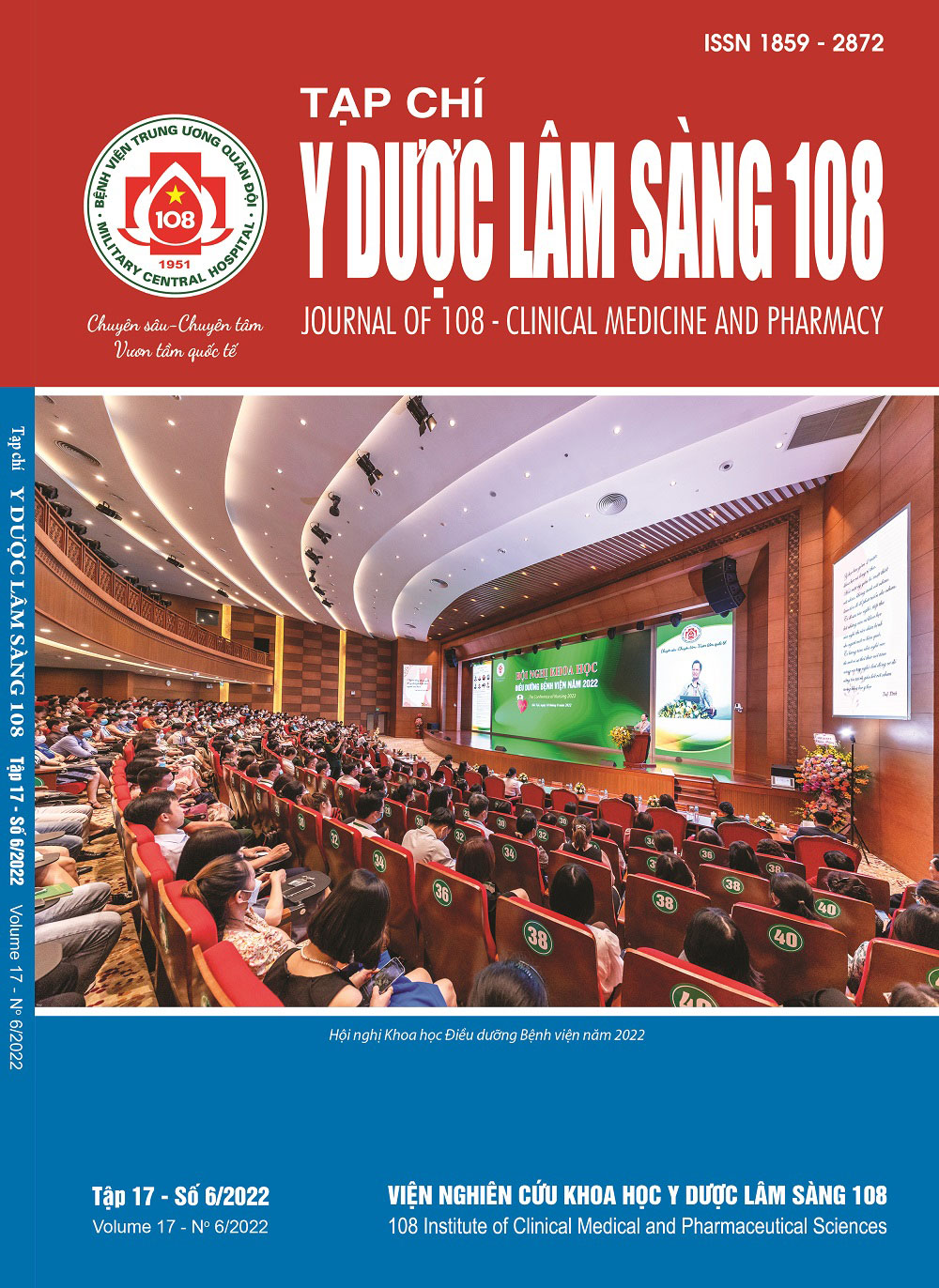Imaging characteristics and value of computed tomography in the diagnosis of cervical lymph node metastasis in patients with differentiated thyroid cancer after total thyroidectomy
Main Article Content
Keywords
Abstract
Objective: To characterize the metastatic cervical lymph nodes and evaluating the value of computed tomography (CT) in the diagnosis of cervical lymph node metastasis in patients with differentiated thyroid cancer after total thyroidectomy and treatment of ¹³¹I. Subject and method: During the period from September 2019 to February 2022, we prospectively studied 280 patients with differentiated thyroid cancer who had undergone total thyroidectomy and treatment of ¹³¹I by contrast enhanced-computer tomography. On radiographs, 556 cervical lymph nodes were detected. Result: Of the total 556 lymph nodes, 374 (67.3%) metastases and 182 (32.7%) benign nodes. The location of metastatic lymph nodes in group VI accounted for the highest rate of 40.4% and group V had the lowest rate of 3.5%. Among the metastatic nodes, 74.1% of the lymph nodes had strong enhancement, 16.0% had signs of necrosis and 17.6% had calcifications. The sign of strong enhancement had a sensitivity of 74.1%, a specificity of 82.4%, a sign of necrosis had a sensitivity of 16.0%, a specificity of 97.3%, a sign of calcification had a sensitivity of 17.6%, specificity 96.7%. Synthesis of signs of CT to diagnose cervical lymph node metastasis had sensitivity 79.4%, specificity 77.5%, accuracy 78.8%. Conclusion: Contrast-enhanced CT is also a valuable method for diagnosing cervical lymph node metastasis in patients with differentiated thyroid cancer after total thyroidectomy.
Article Details
References
2. Ha EJ, Chung SR, Na DG, Ahn HS, Chung J, Lee JY, Park JS, Yoo RE, Baek JH, Baek SM, Cho SW, Choi YJ, Hahn SY, Jung SL, Kim JH, Kim SK, Kim SJ, Lee CY, Lee HK, Lee JH, Lee YH, Lim HK, Shin JH, Sim JS, Sung JY, Yoon JH, Choi M (2021) 2021 Korean Thyroid Imaging Reporting and Data System and Imaging-Based Management of Thyroid Nodules: Korean Society of Thyroid Radiology Consensus Statement and Recommendations. Korean J Radiol 22(12): 2094-2123. doi: 10.3348/kjr.2021.0713.
3. Sakorafas GH, Koureas A, Mpampali I, Balalis D, Nasikas D, Ganztzoulas S (2019) Patterns of lymph node metastasis in differentiated thyroid cancer; Clinical implications with particular emphasis on the emerging role of compartment-oriented lymph node dissection. Oncol Res Treat 42: 143-147. doi: 10.1159/000488905.
4. Hoang JK, Vanka J, Ludwig BJ, Glastonbury CM (2013) Evaluation of cervical lymph nodes in head and neck cancer with CT and MRI: Tips, traps, and a systematic approach. AJR 200: 17-25. doi: 10.2214/AJR.12.8960.
5. Eun NL, Son EJ, Kim JA, Gweon HM, Kang JH, Youk JH (2018) Comparison of the diagnostic performances of ultrasonography, CT and fine needle aspiration cytology for the prediction of lymph node metastasis in patients with lymph node dissection of papillary thyroid carcinoma: A retrospective cohort study. International Journal of Surgery 51: 145-150. doi: 10.1016/j.ijsu.2017.12.036.
6. Wei Q, Wu D, Luo H, Wang X, Zhang R, Liu Y (2018) Features of lymph node metastasis of papillary thyroid carcinoma in ultrasonography and CT and the significance of their combination in the diagnosis and prognosis of lymph node metastasis. JBUON 23(4): 1041-1048.
7. Park JE, Lee JE, Ryu KH, Chung MS, Kim HW et al (2017) Improved diagnostic accuracy using arterial phase ct for lateral cervical lymph node metastasis from papillary thyroid cancer. AJNR Am J Neuroradiol 38: 782-788.
8. Cho SJ, Suh CH, Baek JH, Chung SR, Choi YJ, Lee JH (2019) Diagnostic performance of CT in detection of metastatic cervical lymph nodes in patients with thyroid cancer: systematic review and meta-analysis. European Radiology 29: 4635-4647.
9. Yang SY, Shin JH, Hahn SY, Lim Y, Hwang SY, Kim TH, Kim JS (2020) Comparison of ultrasonography and CT for preoperative nodal assessment of patients with papillary thyroid cancer: diagnostic performance according to primary tumor size. Acta Radiologica 61(1): 21-27.
10. Suh CH, Baek JH, Choi YJ, and Lee JH (2017) Performance of CT in the Preoperative Diagnosis of Cervical Lymph Node Metastasis in Patients with Papillary Thyroid Cancer: A Systematic Review and Meta-Analysis X C.H. Suh, X J.H. Baek, X Y.J. Choi, and X J.H. Lee. AJNR Am J Neuroradiol 38:154-161
11. Sun J, Li B, Li CJ, Li Y, Su F, Gao QH, Wu FL, Yu T, Wu L, Li LJ (2015) Computed tomography versus magnetic resonance imaging for diagnosing cervical lymph node metastasis of head and neck cancer: A systematic review and meta-analysis. OncoTargets and Therapy 8: 1291-1313.
12. Seo YL, Yoon DY, Baek S, Ku YJ, Rho YS, Chung EJ, Koh SH (2012) Detection of neck recurrence in patients with differentiated thyroid cancer: comparison of ultrasound, contrast-enhanced CT and 18F-FDG PET/CT using surgical pathology as a reference standard: (ultrasound vs. CT vs. 18F-FDG PET/CT in recurrent thyroid cancer). Eur Radiol 22: 2246-2254. doi: 10.1007/s00330-012-2470-x.
 ISSN: 1859 - 2872
ISSN: 1859 - 2872
